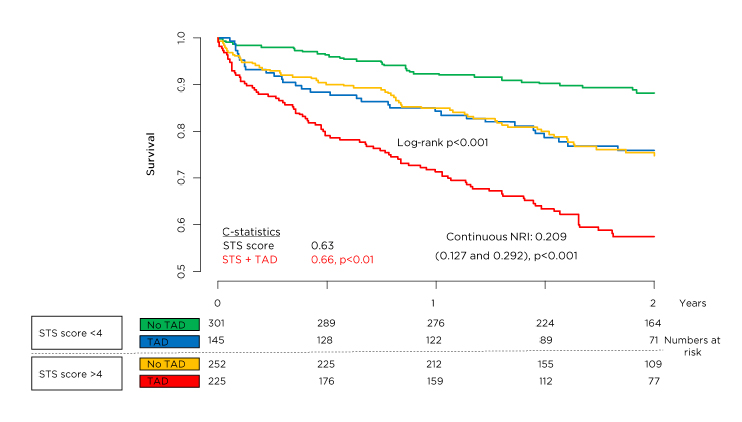BACKGROUND AND AIMS
Transcatheter aortic valve replacement (TAVR) is the treatment of choice in many patients with severe aortic stenosis. The Society of Thoracic Surgeons (STS) score is a well-established risk score to estimate morbidity, mortality, and procedural risks of patients undergoing TAVR. However, tricuspid annular dilatation (TAD), which is an increasingly recognised pathology associated with increased mortality, is not implemented in the STS score. The purpose of this analysis was to investigate the incremental prognostic value of TAD over the STS score.
MATERIALS AND METHODS
The maximal septal-lateral diameter of the tricuspid annulus was measured in 923 patients on three-dimensional multidetector CT datasets. A cut-off of 23 mm/m² body-surface area was revealed by receiver-operating curve statistics and used to define TAD in a previous analysis (data accepted for publication). Incremental prognostic information was tested with C-index statistics and continuous net reclassification improvement. Patients were followed for 2 years and all-cause mortality was defined as the study endpoint.
RESULTS
Of the 923 patients included in this analysis, TAD was found in 370 patients (40%). Patients with TAD had a significantly higher mortality (hazard ratio: 2.18; 95% confidence interval [CI]: 1.71–2.78; p<0.001).
The mean STS score in the investigated patient cohort was 5.6±5.0. TAD provided incremental prognostic information over the STS score when assessed with C-index statistics (a rise from 0.63 to 0.66; p<0.01) or continuous net reclassification improvement (0.209; 95% CI: 0.127–0.292; p<0.001). Estimated survival rates at 2 years were 88.2% (95% CI: 84.5–92.1) in patients with a low STS score (<4) and no TAD and 57.5% (95% CI: 51.1–64.7) in patients with a high STS score (>4) and TAD. Estimated survival rates in patients with a low STS score and TAD and patients with a high STS score and no TAD were similar (75.8%; 95% CI: 68.9–83.5; versus 74.8%; 95% CI: 69.2–80.7, respectively). Kaplan–Meier curves are shown in Figure 1.

Figure 1: Survival stratified of tricuspid dilation and Society of Thoracic Surgeons (STS) score.
The survival of patients after a transcatheter aortic valve replacement procedure, stratified for Society of Thoracic Surgeons (STS) score using a cut-off of 4 and tricuspid annular dilatation.
NRI: net reclassification improvement; STS: Society of Thoracic Surgeons; TAD: tricuspid annular dilatation.
CONCLUSION
TAD is a common entity in patients undergoing TAVR for severe aortic stenosis. It is associated with significantly higher mortality and provides incremental prognostic information over the STS score.








